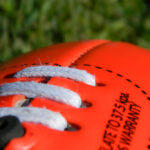NCAA WELLBEING – NON SPORT STRESS
Maeve Smith | Sports Scientist @ Kitman Labs
“you know that while student-athletes may play games, being a student-athlete isn’t a game at all”
Brian Hainline, NCAA Chief Medical Officer
Stress-injury models suggest that athletes experience more physical injuries during times of high stress. Student-athlete stress can come from a variety of sources on and off the field, such as physical, travel, time, academic or social demands (Metzler, 2002). A study by Mann et al., (2016) divided a Student-Athlete’s stress into 3 categories, high physical stress (HPS), high academic stress (HAS), and low academic stress (LAS). The study found that injury during weeks of HAS were almost twice as high as during weeks of LAS. The authors urged coaches to be aware of both physical and academic stress as they both play a significant role in injury risk. Clearly there is a need for coaches to regularly monitor an athlete’s non-sports stress/on-sports load: A simple well-being questionnaire can be an an effective methods for monitoring these variables. Well-being questionnaires can give coaches the information required to identify trends in increased/decreased non-sports stress and allow them to make the appropriate changes to athletes training programmes, mitigating the risk of injury.
A study by the PAC-12 in 2015 found that ‘sleep’ and ‘time’ were the top two sources of stress for student-athletes. The study found that student-athletes spent on average 50 hours per week on their sport. Time spent in sport impacted their time available to study and also increased fatigue levels. Increased fatigue also impacted their perceived ability to study. In continuing with this vicious circle, additional anxiety of not being able to study would leave athletes with more sleepless nights, further hindering both academic athletic performance. In fact, the report stated that “Sleep is the number one thing their athletic time commitments prevent them from doing”.
The PAC-12 report echoed the findings of Humphrey et al. (2000) who found that more than 40 percent of male student-athletes and over half of female student-athletes reported that a lack of time was the most serious cause of stress outside of competition and academic stresses. The resounding comment was that the student-athletes felt there was not enough time to combine academic and athletics to the best of their ability in each area. It should be noted that athletes (and in particular student-athletes) may have some perfectionistic tendencies, to ensure that perfectionism does not become dysfunctional it is suggested that educating athletes about how to achieve an academic-athletic balance could be helpful in reducing stress associated with perceived lack of time.
According to the NCAA, “Intercollegiate athletics embodies a unique and demanding culture. The pressures and demands on 18- to 21-year-old student-athletes are great. Their wins and losses are seen by many, questioned by many, and often criticized publicly”. If, as previously stated, student-athletes experience more physical injuries during times of high stress, surely it should be of prime importance to continually monitor these demanding situations. Furthermore injuries do not just have an impact on students’ athletic life. For example, a broken hand can result in an inability to write or type. Also following a sport-related concussion, athletes are told initially to observe both physical and cognitive rest. Reducing physical activity for an active student-athlete can be a difficult and stressful adjustment. Additionally a prescribed reduction in cognitive demands often involves reduced class time or assignments. These restrictions appear appropriate in the initial week of recovery, but may become harmful later in recovery, as other stressors may emerge (e.g. making up academically upon return and concern over loss of training/conditioning)
In response to the challenges of student-athlete life, the NCAA has developed an Education-Impacting Disabilities and NCAA Waiver Process. This process identifies student-athletes who are struggling (in and out of the classroom) and put steps in place to assist them. Steps to support athletes can include a full academic waiver or partial credits to help them repair their athletic eligibility (in most colleges eligibility is tied to academic performance). Such systems and processes can result in concern that athletes may be given an unfair advantage. In fact, a study by Papanikolaou et. al (2003) found that many student-athletes find themselves unprepared for academic life or falsely believe that they will be treated differently in the classroom because they are athletes. This can be a source of additional stress that impacts on student-athletes academic and athletic performances.
As a coach, a healthy training/study time balance should be sought. Understandably this will ebb and flow throughout the course of the season/academic year as competition or examinations take priority. Monitoring important parameters (sleep, stress and anxiety) is key to checking if an adequate balance has been achieved. A simple daily wellbeing questionnaire can allow coaches to make informed decisions and hopefully negate the risk of injury. In turn, this will allow student-athletes to attain their potential on the field and in the classroom.

 More than Equal’s mission is to close the gender gap in motor sports and find and develop the first female Formula 1 world champion. They will now have an advanced operating system to centralize data for female drivers participating in More than Equal’s pioneering Development Programme.
More than Equal’s mission is to close the gender gap in motor sports and find and develop the first female Formula 1 world champion. They will now have an advanced operating system to centralize data for female drivers participating in More than Equal’s pioneering Development Programme.